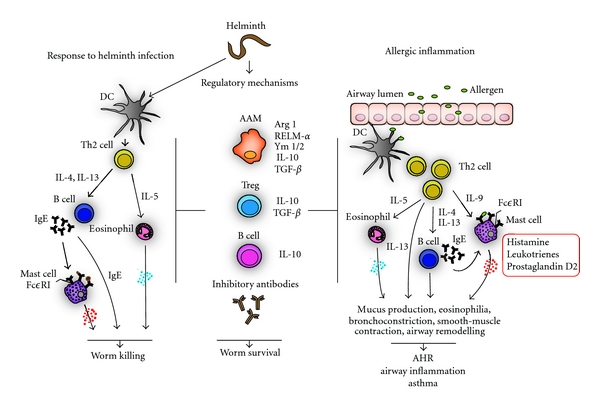Figure 1.

Regulatory and effector mechanisms of Th2-type responses. Th2 immune response in helminth infection: helminth infection induces a protective Th2 immune response. Professional antigen presenting cells such as dendritic cells (DCs) process helminth antigens and display them to CD4+ T cells that differentiate into polarised T helper 2 cells. Th2 cells produce cytokines such as IL-4, -5, and -13 that activate and attract macrophages, eosinophils, and other innate immune cells as well as B cells. IL-4 and -13 induce differentiation of antigen-specific B cells and production of large amounts of antibodies (characteristically IgE). Antibodies opsonise the helminths leading to killing via eosinophils or neutrophils, as well as macrophages by antibody-dependent cellular toxicity (ADCC). IgEs bind to Fcε-receptors (FcεRI) on mast cells (MCs). Sensitized MCs secrete large amounts of histamine and other mediators and facilitate the attraction and accumulation of further immune cells, which result in larvae killing. Regulatory mechanisms in helminth infection: Helminths induce immunoregulation via modulation of immune cells leading to alternatively activated macrophages (AAMs), regulatory T cells (Treg), and B cells. AAMs in mice express among others arginase-1 (Arg 1), resistin-like molecule-α (RELM-α), Ym-1, Ym-2, IL-10, and TGF-β and contribute to wound healing. Treg produce IL-10 and transforming growth factor-β (TGF-β), whereas B cells can elicit regulatory mechanisms via IL-10. These cellular changes lead to modified Th2 immune responses and larvae survival as well as blocking of unrelated inflammation such as allergic immune responses. Allergic inflammation: DCs present allergen-derived peptides to T cells. Stimulation of allergen-specific T cells results in differentiation of CD4+ T cells into Th2 cells that produce Th2 cytokines. IL-4 directs T cell differentiation towards a Th2-related phenotype. IL-5 regulates the recruitment and differentiation of eosinophils and stimulates them to release mediators. Additionally, IL-4 and -13 induce Ig-class switching to IgE by B cells. IgEs bind to high affinity FcεRI on MCs. Sensitized, IL-9-activated, and maturated MCs degranulate and release preformed mediators, including histamine, leukotrienes, and prostaglandins. This allergic inflammatory cascade leads to increased mucus production, eosinophilia, bronchoconstriction, smooth-muscle contraction, and remodelling in the lungs, which result in allergic-airway hyperreactivity (AHR), airway inflammation or asthma. The allergic inflammation may be suppressed by a spill-over effect of immunomodulatory mechanisms of helminth infections.
